Head restraints
WARNING
Head restraints supplement the other vehicle safety systems. They may provide additional protection against injury in certain rear end collisions. Adjust the head restraints properly, as specified in this section. Check the adjustment after someone else uses the seat. Do not attach anything to the head restraint stalks or remove the head restraint. Do not use the seat if the head restraint has been removed. If the head restraint was removed, install and properly adjust the head restraint before an occupant uses the seating position. Failure to follow these instructions can reduce the effectiveness of the head restraints.
This may increase the risk of serious injury or death in a collision.
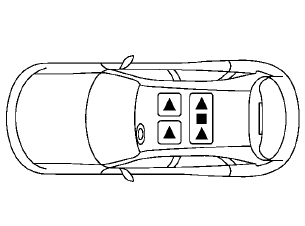
The illustration shows the seating positions equipped with head restraints and headrest.
For Hardtop models, the head restraints and the headrest are adjustable.
For CrossCabriolet models, the front head restraints are adjustable and the rear head restraints are not removable or adjustable.
 Indicates
the seating position is equipped
with a head restraint.
Indicates
the seating position is equipped
with a head restraint.
 Indicates
the seating position is equipped
with an adjustable headrest (for Hardtop models).
Indicates
the seating position is equipped
with an adjustable headrest (for Hardtop models).
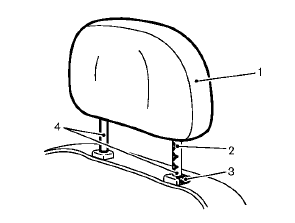
Components
1. Head restraint
2. Adjustment notches
3. Lock knob
4. Stalks
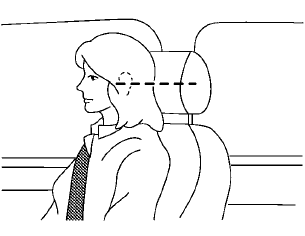
Adjustment
Adjust the head restraint so the center is level with the center of your ears.
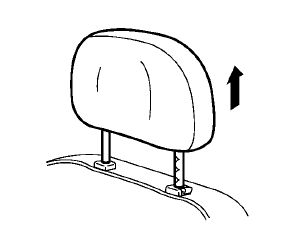
To raise the head restraint, pull it up.
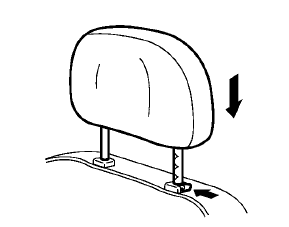
To lower, push and hold the lock knob and push the head restraint down.
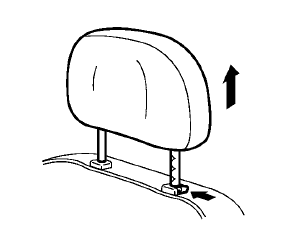
Removal
Use the following procedure to remove the adjustable head restraints.
1. Pull the head restraint up to the highest
position.
2. Push and hold the lock knob.
3. Remove the head restraint from the seat.
4. Store the head restraint properly in a secure
place so it is not loose in the vehicle.
5. Reinstall and properly adjust the head
restraint before an occupant uses the
seating position.
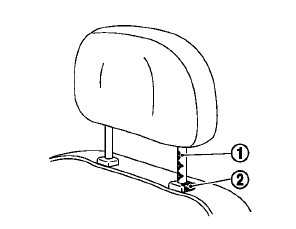
Install
1. Align the head restraint stalks with the holes
in the seat. Make sure that the head restraint
is facing the correct direction. The stalk with
the adjustment notches 1 must be installed
in the hole with the lock knob 2 .
2. Push and hold the lock knob and push the
head restraint down.
3. Properly adjust the head restraint before an
occupant uses the seating position.
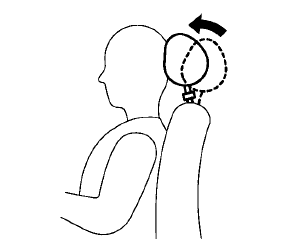
Front-seat Active Head Restraint
The Active Head Restraint moves forward utilizing the force that the seatback receives from the occupant in a rear-end collision. The movement of the head restraint helps support the occupant’s head by reducing its backward movement and helping absorb some of the forces that may lead to whiplash-type injuries.
Active Head Restraints are effective for collisions at low to medium speeds in which it is said that whiplash injury occurs most.
Active Head Restraints operate only in certain rear-end collisions. After the collision, the head restraints return to their original position.
Adjust the Active Head Restraints properly as described earlier in this section.
See also:
Specifications
Engine
This spark ignition system complies with the Canadian standard ICES-002.
Wheels and tires
Road wheel
1: 2WD models 2: AWD models 3: AWD models (P225/55R18 97V)
Dimensions and weights
...
Headlights
Fog may temporarily form inside the lens of the
exterior lights in the rain or in a car wash. A
temperature difference between the inside and
the outside of the lens causes the fog. This is
not a ...
Operating the HomeLink® universal transceiver
The HomeLink® Universal Transceiver, after it is
programmed, can be used to activate the programmed
device. To operate, simply press and
release the appropriate programmed
HomeLink® Universal Tr ...
